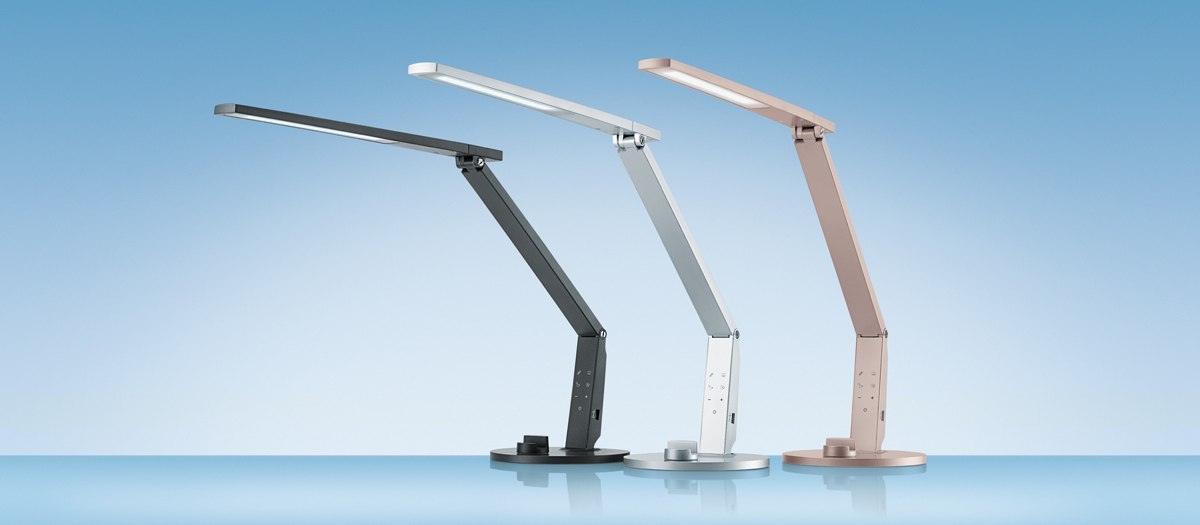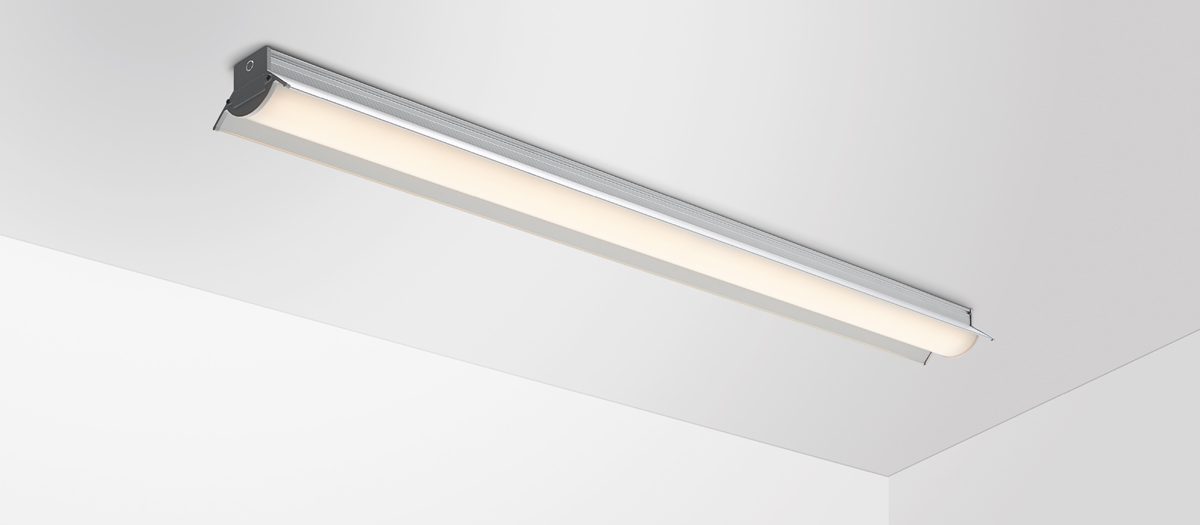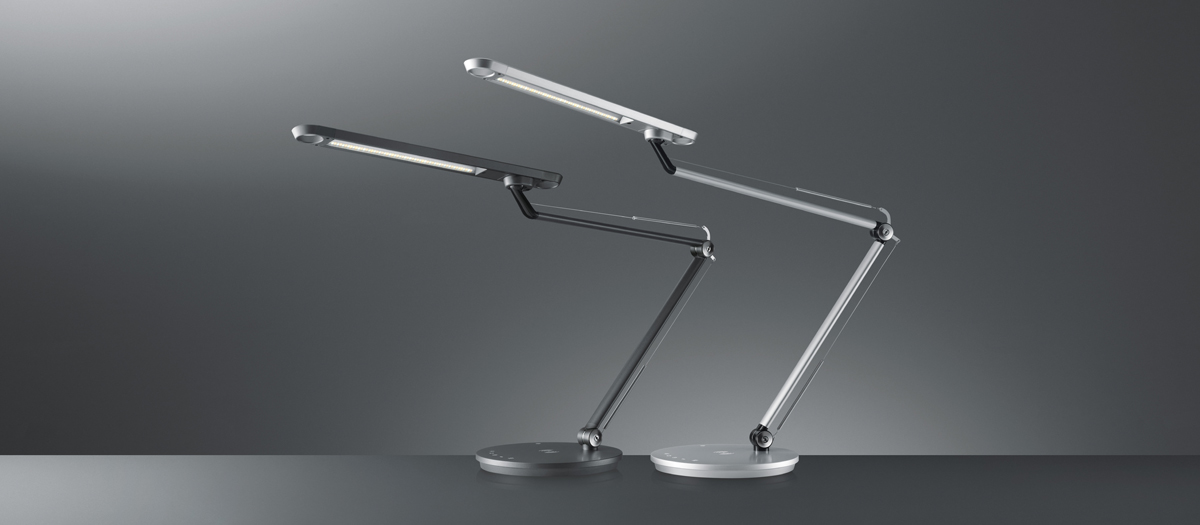Lamps
Today, the Hansa brand is more a «world of light» than a «world of office». Although we do still offer a range of desk accessories under the Hansa brand name, Hansa has now become one of the leading manufacturers of table lamps and floor lamps, and has recently expanded its range to include ceiling lights for offices and homes too.
Light knowledge
Light is good for your health
The sun's light has an invigorating, inspiring and stimulating effect on human beings. The sun has a positive effect on our psyche and therefore on our health in general. People need light to live. In addition to natural light, artificial light also takes on the characteristics of the sun. Good lighting at home or at work can also help us to concentrate and be motivated.
The right light at work
The modern workplace is described in standards. Safety, ergonomics, acoustics, and lighting are all clearly regulated. Employers have to provide the perfect environment. Only where there is optimal, healthy lighting can we expect to see higher motivation and, as a result, higher performance. Poor, inadequate lighting, on the other hand, quickly leads to tired eyes, headaches, and even uncomfortable tension. A balanced relationship between daylight, general ambient lighting and individually controllable lighting conditions is essential. Everyone should be able to create the light that is most comfortable for them at their workstation, thus ensuring optimum visual comfort. Technical criteria should also be considered. These include energy efficiency, illuminance, colour temperature and colour rendering, all of which are crucial when choosing luminaires.
Criteria for buying the right lighting
- Application (living room, office, basic lighting area)
- Technology (energy efficiency, glare reduction)
- ergonomic design
- Material
- Lamp size
- Features (projection, dimmer, etc.)
- Pricing
Lumen (lm)
Lumen is the unit of measurement for the so-called luminous flux of a light source. There is an indication of the brightness of a lamp. Luminous flux indicates how much light a light source emits in all directions. When incandescent lamps were used exclusively, their brightness was indicated by their power consumption in watts. Nowadays, manufacturers must state how many lumens a lamp produces.
Watt (W)
Watts tell you how powerful a lamp is and how much electricity it uses. In the past, the higher the number of watts, the brighter the lamp.
Lux (lx)
Lux is the unit of illuminance. It indicates how much luminous flux (lumen) falls on a given surface. One lux of illuminance means that 1 lumen of luminous flux illuminates an area of 1 m² uniformly. In an office, for example, at least 500 lux illuminance is needed to work at a desk. It is important to understand that illuminance does not reflect the perception of brightness, which depends largely on the properties of the material being illuminated.
Candela
The candela is the unit of luminous intensity. It expresses how much luminous flux is distributed over a given volume. Most luminaires, especially those with LED lamps, do not emit the same luminous intensity in all directions. Luminous intensity is only meaningful with the beam angle. The luminous intensity of incandescent lamps is evenly distributed in almost all directions. The luminous intensity of bee-shaped LED lamps, on the other hand, is often distributed over a solid angle range between 180 and 270 degrees. If two luminaires have the same lumen output but different beam angles, the luminous intensity of the luminaire with the smaller beam angle will be higher.
Kelvin (K)
Kelvin is the unit used to measure colour temperature. The higher the value, the more similar the artificial light is to daylight.
Colour rendering index (Ra)
The colour rendering index of a luminaire can be used to assess how faithfully it reproduces the colours of its surroundings. The more faithfully the colours of objects in the illuminated area are reproduced, the higher the colour rendering index (maximum value: RA 100). If colour rendering is important to you, you should only buy luminaires with a colour rendering index of at least Ra 90.
UGR value
UGR stands for Unified Glare Rating. This refers to the psychological glare effect of a lighting system at a given observer position. Values are categorised on a scale from 10 (= no glare) to 30 (= high glare). For offices, the UGR value should not exceed 19. This means that around 65% of people do not feel disturbed by the light. However, it also means that the remaining 35% are negatively affected by light sources. The UGR cannot be measured, it can only be calculated. It is not a fixed characteristic of a luminaire, but depends on many environmental factors.
LED drivers
In order for LED lamps to work properly, a converter, also known as an LED driver, needs to be used. LED lamps operate on a low, constant direct current, whereas our electricity grid operates on alternating current. An electronic system is therefore required between the mains supply and the lamp to convert and regulate the current flow. A faulty or inappropriate electronic power supply will cause the LED lamp to flicker or fail. This is because the electronic power supply is not providing the correct current flow. It is possible that the electronic power supply is located outside the luminaire, e.g. in the plug or separately. It may also be built into the luminaire itself. Retrofit LED lamps, i.e. LED lamps with conventional sockets such as E27 or G9, are LEDs with a built-in electronic power supply. Defective LED luminaires often have a defective electronic power supply, as the LEDs themselves only show sporadic damage.
Average lamp life:
The average rated life refers to the period from the time the lamp is first switched on to the time when only 50% of the lamps tested are still working properly. So a 20,000-hour average rated life on the packaging of an LED luminaire means that the test procedure has shown that half of the lamps tested will fail after that time.
Rated or lifetime of LED lamps:
The average life, rated life or lifetime of an LED lamp is the time from when the lamp is put into service to when the average luminous flux (lumens) of all the lamps tested is less than 70%. This means that the lamps have lost at least 30 percent of their brightness. This is known as degradation and simply means that the light output has decreased. Some manufacturers therefore indicate the light degradation as L70 on the product. Depending on the test method, you may also find information such as L50 (less than 50% brightness) or L80 (less than 80% brightness) of the original brightness. However, LED lamps do not have any direct wear parts; at most, the driver can cause problems. Consumers can therefore use bright LED lamps for years with sufficient brightness, even with reduced luminous flux.
All day with LED lighting
Lighting with LED light makes it possible to match the light colour to the natural daylight curve, which is between 3,000 and 12,000 Kelvin. For millions of years, people have based their activities on the light of the sun, and from a physical standpoint, this rhythm is essential for maintaining our health. However, people's lifestyles are moving further and further away from this. Artificial lighting can recreate the dynamics of daylight and its many positive effects. Today's LED luminaires make it possible to change the light colour and brightness continuously. This is where the HCL (Human Centric Lighting) concept comes in. In addition to the visual effect, the emotional and non-visual effects of light are also considered. HCL is often understood to mean adapting lighting to the natural progression of daylight. This is not only about illuminance, but also about the changing colour temperature of the light.
In other words:
Warm white light in the morning: 2,000 – 3,300 Kelvin
Cold white light at midday: 3,300 – 5,300 Kelvin
Warm white light in the evening: 2,000 – 3,300 Kelvin
Warm white light below 3,300 Kelvin has a low blue component and has a soothing effect. It is ideal for bedrooms or in the evening at home. Neutral white light between 3,300 and 5,300 Kelvin is ideal for working. Many office luminaires are regularly 4,000 Kelvin. 5,000 Kelvin is more suitable for workshops. Daylight white, starting at 5,300 Kelvin, is suitable for factory floors, bright shops or outdoors.
Pictogram explanations for luminaires
Disposal and sustainability:
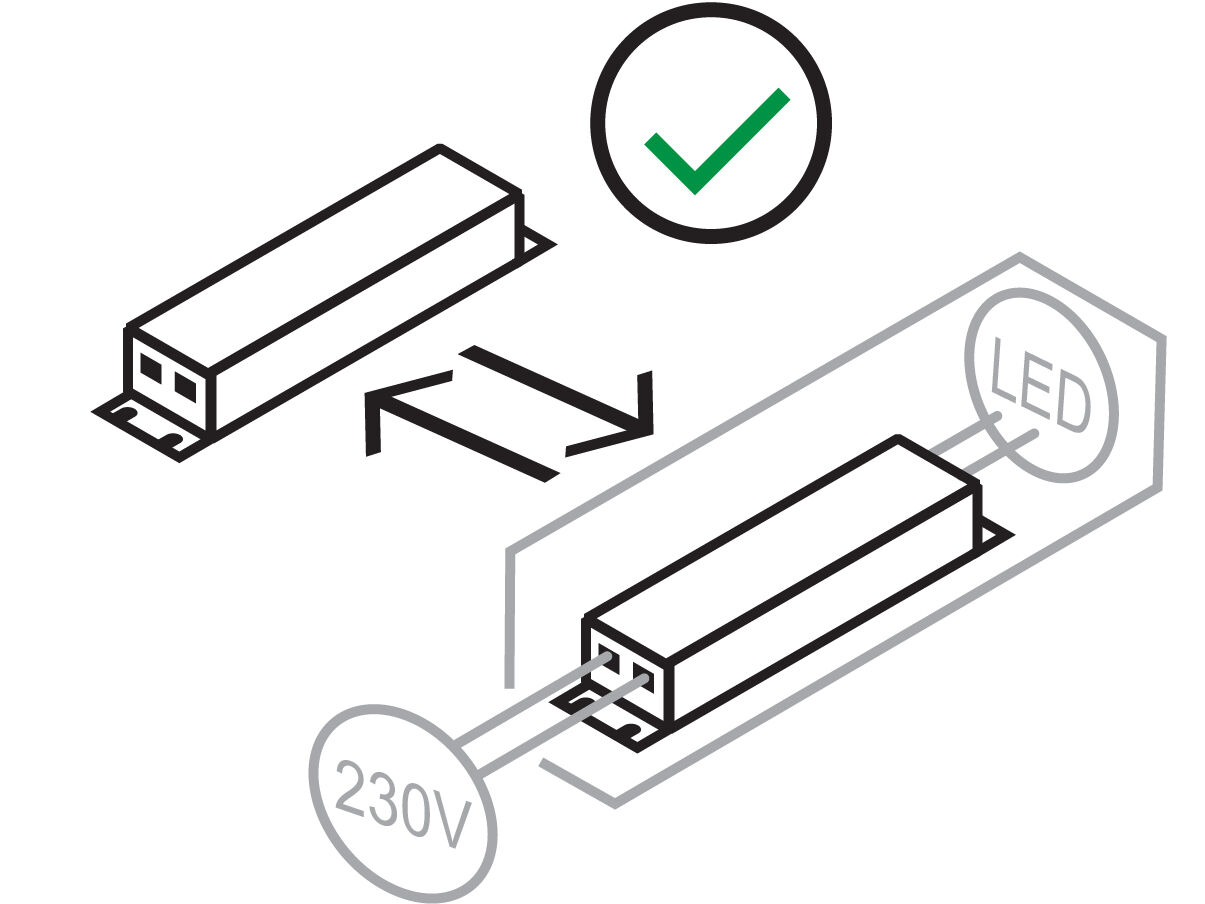
End user replaceable control gear
It can be replaced
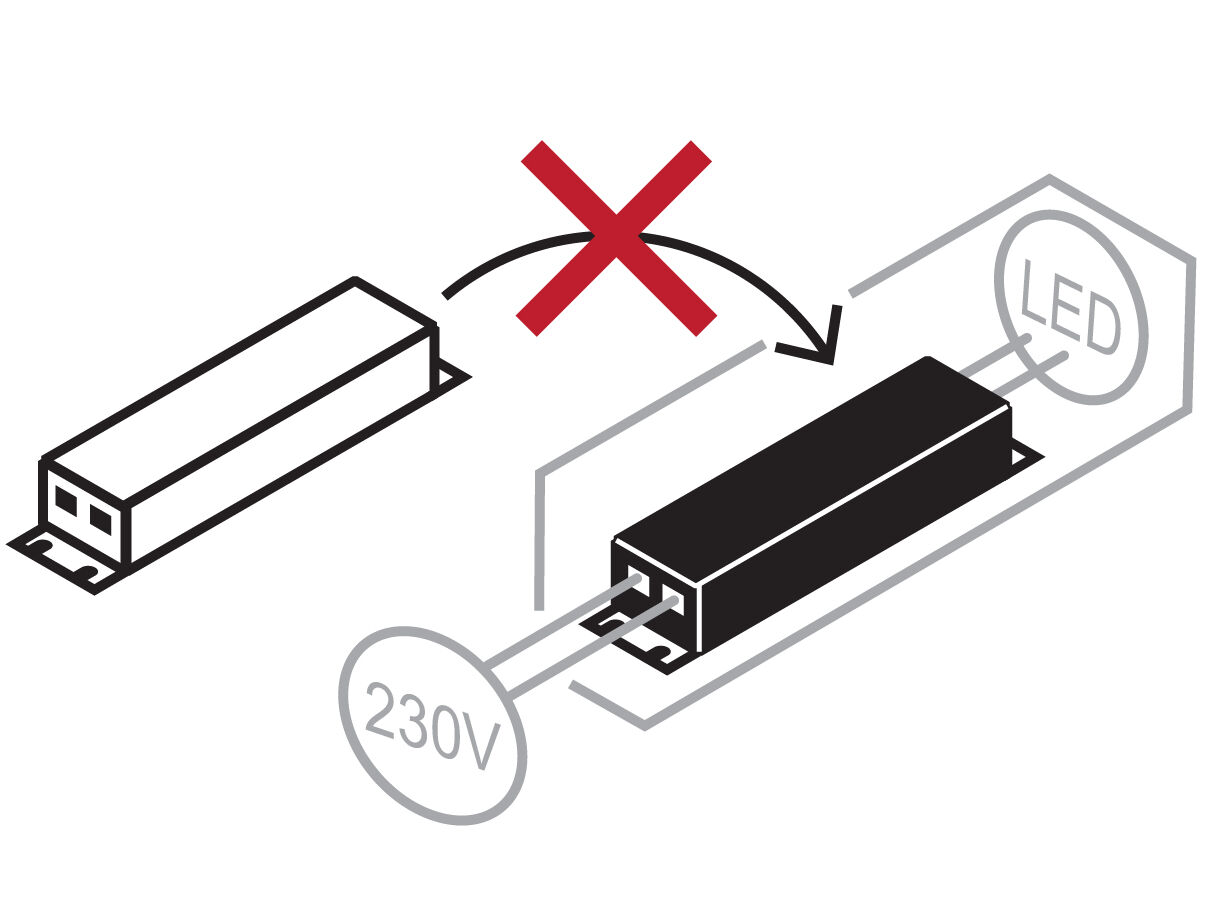
Non-replaceable control gear
It cannot be exchanged
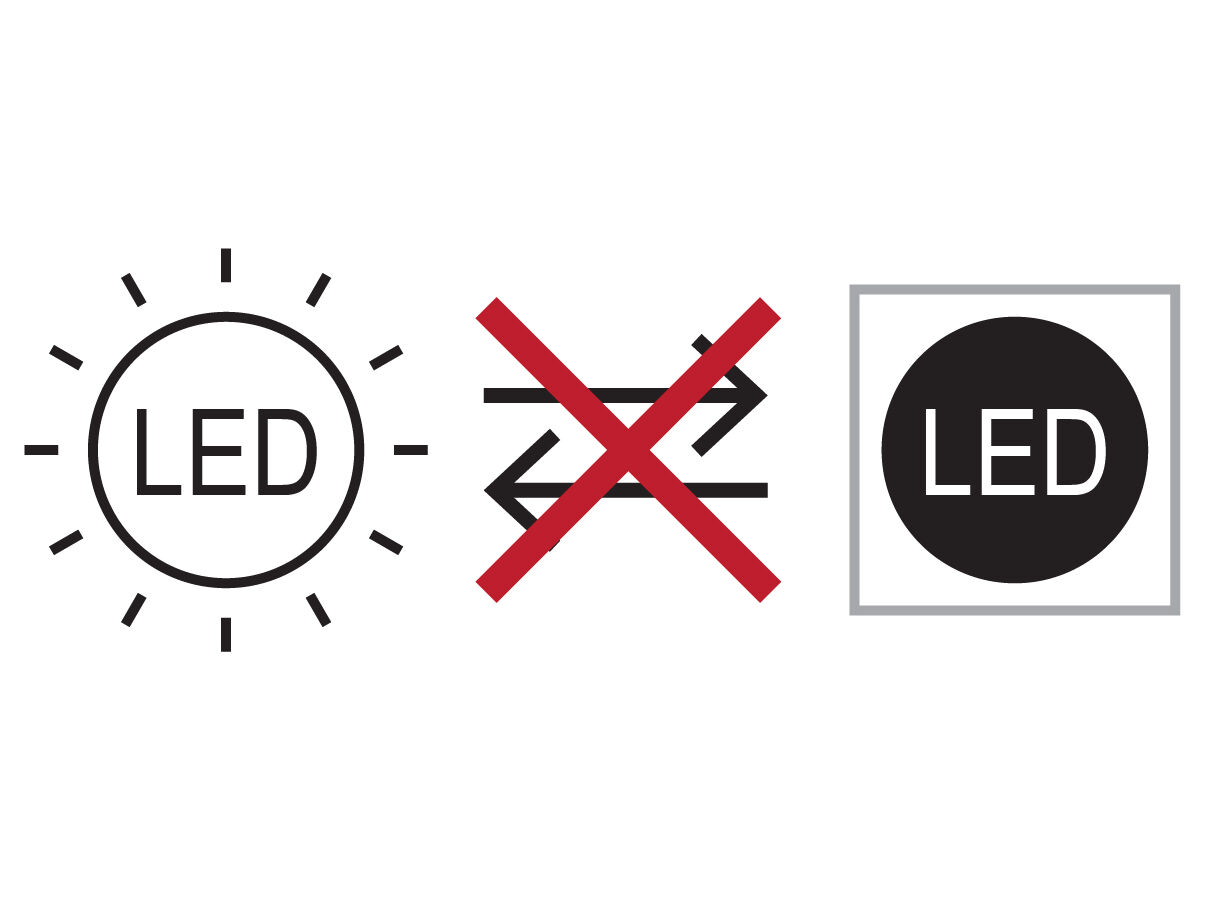
Non replaceable light source
The light source can not be replaced

The marked device is not to be disposed with normal household waste
It has to be collected or delivered to a collection point

Recycling codes provide information about the material used
01- PET: Polyethylene terephthalate (packaging material)






